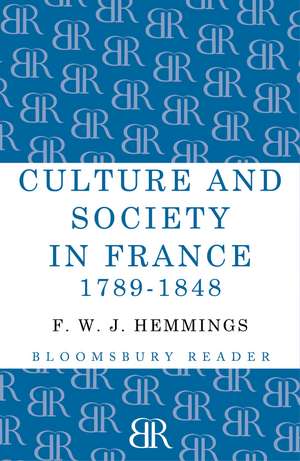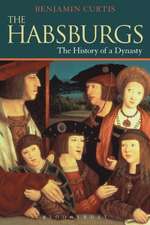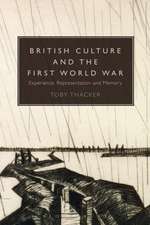Culture and Society in France 1789-1848
Autor F. W. J. Hemmingsen Limba Engleză Paperback – 14 noi 2012
Preț: 87.93 lei
Preț vechi: 135.04 lei
-35% Nou
Puncte Express: 132
Preț estimativ în valută:
16.83€ • 18.27$ • 14.14£
16.83€ • 18.27$ • 14.14£
Carte tipărită la comandă
Livrare economică 23 aprilie-07 mai
Preluare comenzi: 021 569.72.76
Specificații
ISBN-13: 9781448205073
ISBN-10: 1448205077
Pagini: 476
Dimensiuni: 153 x 234 x 24 mm
Greutate: 0.66 kg
Editura: Bloomsbury Publishing
Colecția Bloomsbury Reader
Locul publicării:London, United Kingdom
ISBN-10: 1448205077
Pagini: 476
Dimensiuni: 153 x 234 x 24 mm
Greutate: 0.66 kg
Editura: Bloomsbury Publishing
Colecția Bloomsbury Reader
Locul publicării:London, United Kingdom
Notă biografică
Frederick William John Hemmings was born in Southampton in 1920. Hemmings served in the Second World War, decrypting German codes in the Army Intelligence Corps, but in 1946 he returned to academic life in Oxford, completing his DPhil in 1949, a groundbreaking study that was published the following year by Oxford University Press: The Russian Novel in France 1884-1914.Hemmings made his mark as a pioneer of Zola studies and is known as the foremost Zola critic in the English-speaking world. Further studies on Zola and Stendhal were published in later years, as were books on two other major 19th-century French writers: The King of Romance: A Portrait of Alexandre Dumas (1979) and Baudelaire the Damned (1982). This project of Balzacian and Zolaesque proportions was realised all the more remarkably during a busy nine-year term of office as head of the French department at Leicester University, where he was a hugely respected literary scholar. Hemmings was twice married and left behind one son and one daughter when he died in Leicester in 1997.
Cuprins
Introduction1 On the Eve of the RevolutionLaclos: Les Liaisons dangereusesBeaumarchais: Le Mariage de FigaroDavid: Le Serment des Horaces2 The RevolutionDavid and TalmaThe Coming of the Commercial TheatreIdeology and the StageMusic and the RevolutionThe FestivalsPainting during the RevolutionThe Post-Thermidorian Reaction3 The Napoleonic AgeThe Founding of the Musée du LouvreArt as the Spoils of WarNapolean, Patron of the ArtsArchitecture under the EmpireLiterature in the ProvincesThe Novel of TerrorThe MelodramaThe Literature of the EmigrationThe Literature of the Opposition4 The Restoration: Louis XVIIIThe Social BackgroundThe Aftermath of Waterloo: Delavigne and BerangerCensorship under the RestorationStage Sets, Panorama, DioramasGericaultThe Anglo-German Cultural InvasionStendhal, Delecluze and the Liberal RomanticsRoyalist Romanticism5 Romanticism at Flood-Tide: The Reign of Charles X1824: A Turning-PointIngresDelacroixThe Arsenal GroupThe Shakespeare Season at the OdeonBerlioz and the Romantic Revolution in MusicScribe and the VaudevilleTalma, Taylor and the Reform of the Comedie-FrancaiseHugo's CenacleThe Triumph of Romanticism on the Stage6 The July MonarchyThe New NovelBooksellers, Book-Buyers and Book-BorrowersThe Cultural Consequences of Saint-SimonThe Jeunes-FranceStar ActosThe Decline of the Romantic DramaGrand OperaPublic Concerts and Private RecitalsThe Art World: Producers and ConsumresCommissioned ArtThe roman-feuilletonNotesBibliography












